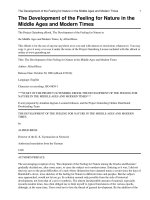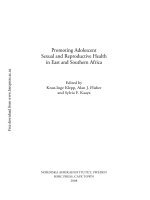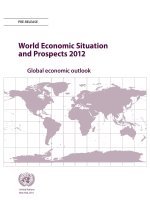Middle East and North Africa Quarterly Economic Brief: Growth Slowdown Extends into 2013
Bạn đang xem bản rút gọn của tài liệu. Xem và tải ngay bản đầy đủ của tài liệu tại đây (682.64 KB, 11 trang )
<span class='text_page_counter'>(1)</span><div class='page_container' data-page=1></div>
<span class='text_page_counter'>(2)</span><div class='page_container' data-page=2>
© 2014 International Bank for Reconstruction and Development / The World Bank
1818 H Street NW, Washington DC 20433
Telephone: 202-473-1000; Internet: www.worldbank.org
Some rights reserved
1 2 3 4 17 16 15 14
This work is a product of the staff of The World Bank with external contributions. The findings, interpretations, and
conclusions expressed in this work do not necessarily reflect the views of The World Bank, its Board of Executive
Directors, or the governments they represent. The World Bank does not guarantee the accuracy of the data included
in this work. The boundaries, colors, denominations, and other information shown on any map in this work do not
imply any judgment on the part of The World Bank concerning the legal status of any territory or the endorsement
or acceptance of such boundaries.
Nothing herein shall constitute or be considered to be a limitation upon or waiver of the privileges and immunities of
The World Bank, all of which are specifically reserved.
<b>Rights and Permissions </b>
This work is available under the Creative Commons Attribution 3.0 IGO license (CC BY 3.0 IGO)
Under the Creative Commons Attribution license, you are free to
copy, distribute, transmit, and adapt this work, including for commercial purposes, under the following conditions:
<b>Attribution—Please cite the work as follows: Shanta Devarajan, Lili Mottaghi. 2013 “Growth Slowdown Extends </b>
into 2013” Middle East and North Africa Quarterly Economic Brief, (July), World Bank, Washington, DC.
Doi: 10.1596/978-1-4648-0396-3 License: Creative Commons Attribution CC BY 3.0 IGO
<b>Translations—If you create a translation of this work, please add the following disclaimer along with the </b>
attribution: <i>This translation was not created by The World Bank and should not be considered an official World </i>
<i>Bank translation. The World Bank shall not be liable for any content or error in this translation.</i>
<b>Adaptations—If you create an adaptation of this work, please add the following disclaimer along with the </b>
attribution: <i>This is an adaptation of an original work by The World Bank. Responsibility for the views and opinions </i>
<i>expressed in the adaptation rests solely with the author or authors of the adaptation and are not endorsed by The </i>
<i>World Bank.</i>
<b>Third-party content—The World Bank does not necessarily own each component of the content contained within </b>
the work. The World Bank therefore does not warrant that the use of any third-party-owned individual component or
part contained in the work will not infringe on the rights of those third parties. The risk of claims resulting from such
infringement rests solely with you. If you wish to re-use a component of the work, it is your responsibility to
determine whether permission is needed for that re-use and to obtain permission from the copyright owner.
Examples of components can include, but are not limited to, tables, figures, or images.
All queries on rights and licenses should be addressed to the Publishing and Knowledge Division, The World Bank,
1818 H Street NW, Washington, DC 20433, USA; fax: 202-522-2625; e-mail:
</div>
<span class='text_page_counter'>(3)</span><div class='page_container' data-page=3>
<b> </b>
<b>HIGHLIGHTS </b>
While the focus has been on the recent change in government in Egypt, five countries in the Middle East and North
Africa Region, including Egypt, Tunisia, Lebanon, Jordan and Iran are facing a growth slowdown, rising fiscal deficits
and debt, and high unemployment and inflation. Continued political turmoil in Egypt and spillovers from the civil
war in Syria to Jordan and Lebanon threaten to make their economic situation worse. While easing political
tensions in Tunisia and post-election improvements in Iran’s international relations may help these countries, the
overall macroeconomic outlook in all five countries for the rest of 2013 is grim.
<b>Egypt.</b>
Economicgrowth likely slid in the second half of 2012/13—before the arrival of the new governmentand financial support from Gulf countries—as data show signs of a slowdown in industrial production. After a
sharp rebound in the third quarter of 2011/12, growth has been on a downward slide, falling by 2 percentage
points in the first half of 2012/13 compared to the second half of the previous year, mainly as a result of lower
investment. Annual growth is estimated to be around 2 percent in the fiscal year (ended in June 2013) marking
the third consecutive year of sluggish growth.
<b>Tunisia.</b>
The economy recovered in 2012 as tourism related activities and FDI inflows rebounded, but therecovery lost momentum due to security concerns, following the assassination of a well-known political leader
in Feb 2013. Real GDP growth fell to 2.6 percent in the first quarter of 2013, half the rate recorded in the
same period in 2012. Recovery in the Euro area and Libya (Tunisia’s main trading partners) as well as easing
political tensions could accelerate growth in 2014.
<b>Lebanon.</b>
Growth has remained highly volatile due to the ongoing conflict in Syria. Lebanon’s economy hasgrown between 1-3 percent over the past two years, significantly slower than the 7 percent and higher rates
seen during the pre-crisis period. Political and economic spillovers from the Syrian crisis continue to dampen
hope for recovery in tourism, real estate and wholesale trade (key drivers of growth). Growth is projected to
remain around 2 percent in 2013.
<b>Jordan.</b>
Economic activity has remained weak due to turmoil in Egypt and spillovers from conflict in Syria.Security concerns have lowered investment flows, tourism and remittances while the government faces
challenges dealing with widening twin deficits and Syrian refugees. Real GDP growth stood at 2.7 percent in
2012, about half the average growth rate recorded in the pre-crisis period. Growth is expected to pick up
slightly in 2013 to above 3 percent but will remain subdued given the uncertainty about the Syrian conflict.
<b>Iran.</b>
The June presidential elections led to the victory of reformists-backed candidate Hassan Rouhani. Thenew government faces serious challenges dealing with a dire economy. Growth shrunk by 2 percent in 2012 as
oil production declined sharply due to international sanctions. The currency has lost more than 70 percent of
its value since March 2012 and the inflation rate surpassed 34 percent in the last quarter of 2012. Economic
activity will remain sluggish in 2013, with prospects of gradual improvement as the new government takes
over in August.
Prepared by Lili Mottaghi, with valuable comments from Manuela Ferro, Elena Ianchovichina and Christina Wood,
under the guidance of Shanta Devarajan.
<b>Office of the Chief Economist Issue 1 July 2013</b>
</div>
<span class='text_page_counter'>(4)</span><div class='page_container' data-page=4>
Issue 1 July 2013 2
MENA Quarterly Economic Brief
<b>EGYPT </b>
On July 3, 2013, following mass protests against
President Morsi, the military intervened and
removed him from office. A temporary
government has been set up, and steps to set a
date for new elections have been taken.
Nevertheless, political turmoil and uncertainty
continue to weigh heavily on the Egyptian
economy. Growth that rebounded in the third
quarter of 2011/12, slipped in the first half of
2012/13. Real GDP growth decelerated by 2
percentage points compared to the second half
of the previous year.1 The deceleration was
triggered by a fall in domestic and foreign
investment as political and economic policy
uncertainty continued to keep investment
decisions on hold. Data from the Central Bank
show that total investment declined by more
than 1 percent of GDP in the first half of
2012/13 compared with the same period the
previous year. Foreign direct investment
continued its downward spiral and inflows
reached near zero in the second quarter of
2012/13. Consumption has been the main
driver of growth since the revolution.
Output in the major sectors of the
economy--manufacturing, construction, trade and
tourism—has remained weak. Industrial
production (mainly manufacturing, mining and
utilities) that showed some signs of recovery
during the second quarter of 2012/13
decelerated in the third quarter. On a positive
note, tourism (and related activities),
accounting for more than 13 percent of GDP,
showed some signs of recovery as tourist
arrivals increased by 20 percent in the first
three months of 2013 (q/q). But arrivals are
estimated to remain at about 11 million in
2013, well below the pre-revolution level of 14
million visitors.
The slowdown in economic activity led to a rise
in the official unemployment rate, which
1
Data are presented in Egypt’s fiscal year (July-June).
reached 13.2 percent in the first quarter of
2013, while unemployment among 20-24 year
olds was 42 percent.
<b>Real GDP growth has slowed down following a </b>
<b>rebound in 2011/12Q3</b>
Source: Ministry of Planning. Data for 2010/11Q3 refer to
the first three months of 2011 marking the revolution.
<b>Quarterly industrial production remains sluggish </b>
-2.2
-1.2
-0.2
0.8
1.8
2.8
-6
-4
-2
0
2
4
6
8
2008/09Q3 2009/10Q3 2010/11Q3 2011/12Q3 2012/13Q3
Net FDI (US$bn, RHS)
GDP growth, percent
70
75
80
85
90
95
100
105
110
115
2010/11Q4 2010/11Q4 2011/12Q4 2012/13Q4
Industrial production (seasonally adjusted 2010M01=100)
8
9
10
11
12
13
14
2009Q1 2009Q3 2010Q1 2010Q3 2011Q1 2011Q3 2012Q1 2012Q3 2013Q1
Unemployment rate (percent)
</div>
<span class='text_page_counter'>(5)</span><div class='page_container' data-page=5>
Issue 1 July 2013 3
MENA Quarterly Economic Brief
Egypt faces shrinking fiscal space as fiscal and
external deficits are expected to remain
elevated going forward. Financing needs are
large, and have been accumulating over the
past two years, but Egypt’s twin deficit problem
pre-dates the Arab Spring. Though Arab
countries have been partially funding the
balance of payments deficit--$12 billion was
pledged by Saudi Arabia, Kuwait and UAE
following the recent change in
government--financing needs have been primarily covered by
drawing down international reserves (which
reached less than 3 months of imports in May
2013) and building up domestic debt. Official
data show that government domestic debt
increased by 4 percent in the third quarter of
2012 relative to the second quarter of the same
year and is estimated to reach a record high of
87 percent of GDP in 2013.
The Egyptian Pound (EGP) weakened against
major currencies as the government relied
more on domestic banks for financing its twin
deficits. Official data show that, after the
Central Bank’s fifth auction in June, the
Egyptian Pound (EGP) plunged again, reaching
7.03 Egyptian pounds to the US dollar in late
June. The currency has fallen by 12 percent
against the US dollar since the auctions were
introduced in December. The EGP has been
weakening even further in the parallel market
as well as the forward market. These auctions,
together with increasing Central Bank financing
of the government, have kept inflation rates
high. Monthly data produced by the Central
Agency for Public Mobilization and Statistics
(CAPMAS) show that the annual inflation rate
increased to 9 percent in May 2013 (from 8.6
percent the previous year). The increase in
inflation is comprised of increases in food and
accommodation & food services items. Prior to
the change in government, the IMF had
projected the annual inflation rate to accelerate
to 13.7 percent in the next fiscal year.
<b>Foreign reserves and official exchange rate under </b>
<b>pressure by large financing needs </b>
<b>Domestic debt is rising as government </b>
<b>financing needs mount </b>
Source: World Bank and Central Bank of Egypt.
-14
-12
-10
-8
-6
-4
-2
0
FY08/09 FY09/10 FY10/11 FY11/12 FY12/13e FY13/14p
Fiscal balance, % of GDP
Current account balance, % of GDP
<b>Egypt’s twin deficit problem pre-dates the revolution</b>
5.7
6
6.3
6.6
10
15
20
25
30
2011M05 2012M01 2012M09 2013M05
International reserves, US$ bn
Official exchange rate (EGP/US$, RHS)
55
60
65
70
75
80
85
90
2007/08 2008/09 2009/10 2010/11 2011/12 2012/13p
</div>
<span class='text_page_counter'>(6)</span><div class='page_container' data-page=6>
Issue 1 July 2013 4
MENA Quarterly Economic Brief
<b>TUNISIA </b>
The Tunisian economy rebounded in 2012.
Growth turned positive in the first quarter of
2012 reaching 4.9 percent mainly due to the
“base effect” following a contraction of 3.9
percent in the same period the previous year.
The economy extended its recovery to the
fourth quarter of 2012 on the back of a strong
rebound in tourism related activities
(accounting for more than 7 percent of GDP)
and in the mining sector. Both sectors were hit
hard during the revolution. On the demand
side, growth was fueled by consumption
resulting from a rise in government spending.
But the economic recovery lost momentum in
the first quarter of 2013 as FDI inflows and
tourism receipts were hit again by security
concerns following the assassination of a
political figure in February. Total FDI declined by
9 percent over the first two months of 2013,
compared to the same period of 2012. Data
published by the Foreign Investment Promotion
Agency (FIPA) show that FDI inflows to the
tourism and real estate sectors fell to near zero.
FDI inflows also declined in the industrial and
services sectors but less than in the other two
sectors. On the positive side, FDI inflows to the
finance sector almost tripled during this period.
The sharp rebound in tourism receipts in 2012
lost momentum in the first quarter of 2013,
following the unrest. Data published by the
National Office of Tunisian Tourism (ONTT)
show a decline of 3 percent in total receipts in
the first quarter of 2013, compared with the
same period of the previous year. The number
of tourist arrivals also decreased by 3 percent
bringing the total down to 923,000 from
940,000. The decline was largely due to fewer
visitors from Europe and Maghreb countries
particularly Libya.
<b>Growth recovery stalling due to political and </b>
<b>economic policy uncertainty </b>
Source: Central Bank of Tunisia
-6
-4
-2
0
2
4
6
8
2008Q1 2009Q1 2010Q1 2011Q1 2012Q1 2013Q1
Real GDP growth
GDP growth (percent)
17
2
1
0
0
50
100
150
200
250
300
350
2010M2 2011M2 2012M2 2013M2
Industries Tourism and real estate (data labled) Services Finance Energy
FDI inflows declined in tourism and real estate following the 2011 revolt
in MTD
-50
-35
-20
-5
10
25
40
55
70
2011M1-M3 2012M1-M3 2013M1-M3
Number of arrivals (percentage change
over the same period in previous year)
Tourism revenues (percentage change
over the same period in previous year)
The rebound in tourist arrivals and revenues was hit again
by security concerns
</div>
<span class='text_page_counter'>(7)</span><div class='page_container' data-page=7>
Issue 1 July 2013 5
MENA Quarterly Economic Brief
The unemployment rate in Tunisia was high
even before the revolution, hovering around 13
percent. After the revolution and with
weakened economic activity, unemployment
increased sharply and reached 18.1 percent in
the first quarter of 2012 due to slow tourism
(tourism related activities provided 400,000
jobs, employing about 26 percent of workers)
and the return of Tunisians from Libya.
Unemployment rates have since been on a
declining trend as these two factors have
started to recede. The results of the National
Survey on Population and Employment of the
first quarter of 2013 show that unemployment
was 16.5 percent in the first quarter of 2013,
down 0.2 percentage points from the fourth
quarter of 2012. Among graduates with higher
education, the unemployment rate was 33.2
percent, with female graduates at 45 percent
compared to 22.6 percent for their male
counterparts.
<b>LEBANON </b>
Lebanon’s economy is entering its third
consecutive year of sluggish growth as security
risks arising from the ongoing Syrian conflict,
interrupted real estate activity; slowed tourism
receipts and disrupted trade routes have
destabilized the economy. Real GDP
decelerated sharply from 7 percent growth in
2010 to below 2 percent in 2011 and reached
below 1 percent in 2012. The slowdown has
continued in the first quarter of 2013 with
quarter-on-quarter GDP growth declining to 1.2
percent from 2.6 percent in Q1 of 2012. The
World Bank estimates annual growth to remain
low, hovering around 2 percent in 2013, given
the current security situation. Weak economic
activity is expected to raise the unemployment
rate above its already high level of 11 percent.
<b>Unemployment rates were high among graduates </b>
<b>even before the revolution</b>
Source: National Institute of Statistics
<b>Ongoing conflict in Syria dashes hope for a growth </b>
<b>recovery in Lebanon for 2013 </b>
Source: Institute of International Finance
13
18.9 <sub>18.1</sub>
17.6 17 16.7 16.5
0
5
10
15
20
25
30
35
40
2010 2011 2012Q1 2012Q2 2012Q3 2012Q4 2013Q1
graduates of higher education Unemployment rate
Unemployment is uncomfortably high among graduates
in percent
-2
0
2
4
6
8
10
12
2010Q1 2010Q3 2011Q1 2011Q3 2012Q1 2012Q3 2013Q1
Real GDP growth has been on declining trend since 2011
GDP growth
Annual GDP growth
</div>
<span class='text_page_counter'>(8)</span><div class='page_container' data-page=8>
Issue 1 July 2013 6
MENA Quarterly Economic Brief
The real estate sector, accounting for 13
percent of GDP, has contracted sharply since
the beginning of 2011. The slowdown in the
property market has been extended to the first
quarter of 2013 as demand from foreigners,
particularly those from Arab countries, has not
yet shown signs of recovery. Due to weaker
demand, the number of new building permits
issued declined by 27 percent q/q in the first
quarter of 2013. The tourism sector is still weak
due to security concerns. The number of tourist
arrivals reached its lowest level since 2008
totaling 274 thousands in the first quarter of
2013, a decline of 12.5 percent compared with
the same period in the previous year, largely as
a result of a sharp fall in visitors from Arab
countries. The number of tourists from GCC
countries, accounting for more than half of the
tourists, declined sharply as governments
warned citizens against travelling to Lebanon
due to security reasons.
Weak economic activity combined with a
widening fiscal deficit has further constrained
the government’s fiscal space. The fiscal deficit
as a percent of GDP has almost doubled since
2011 and is estimated to widen to 9.2 percent
of GDP in 2013 (from 5.7 in 2011) due to
implementation of a large fiscal stimulus -
including a sizable rise in wages and salaries -
that has been in place since 2012. The
government’s large financing needs have
translated into higher public debt, which
escalated from US$70 bn in January 2012 to
over US$75 bn in December 2012. The pace of
increase in public debt accelerated in the first
quarter of 2013 compared to the same period
in the previous year, suggesting an upward
trend for the rest of the year. On the positive
side, the Central Bank has been maintaining
large international reserves (covering more
than 17 months of imports) which could be
used as a buffer during a downturn.
<b>Tourists from Arab countries declined the most as </b>
<b>Syria conflict continues </b>
<b>Government debt is rising together with </b>
<b>international reserves while growth stalls </b>
Source: Ministry of Finance, Banque du Liban, Central
Administration of Statistics, Association of Banks in Lebanon.
-35
-30
-25
-20
-15
-10
-5
0
5
10
Building permits, % change over the same period in previous year
Building permits, a key driver of Lebanon's growth is declining
-35
-30
-25
-20
-15
-10
-5
0
2013M01 2013M02 2013M03
Tourist arrivals, % change 2013/2012
Tourist arrivals from Arab countries , % change
2013/2012
60
62
64
66
68
70
72
74
76
30
31
32
33
34
35
36
37
38
39
40
2010M01 2010M08 2011M03 2011M10 2012M05 2012M12
Public debt , US$bn(RHS)
Total reserves , US$bn
</div>
<span class='text_page_counter'>(9)</span><div class='page_container' data-page=9>
Issue 1 July 2013 7
MENA Quarterly Economic Brief
<b>JORDAN </b>
In Jordan, spillovers from turmoil in Syria and
cutbacks in energy exports from Egypt have
dramatically slowed economic activity. GDP
growth was 1 percent lower (q/q) in the last
quarter of 2012 compared to the same period
the previous year. The slowdown in GDP was a
result of contraction in the construction sector
as well as a sharp decline in value added in the
agriculture and mining sectors due in part to
the disruption of transportation through Syria.
Official data for the first three months of 2013
show GDP growth has picked up to 2.6 percent
from 2.2 percent in the fourth quarter of the
previous year. The economy is expected to
expand by about 3 percent in 2013, in particular
due to a large number of Syrian refugees
contributing to consumption. But it remains
well below the robust growth registered over
the past decade. Private and public
consumption have remained the main
demand-side drivers of growth over the past three years.
Tourism, worker remittances and FDI inflows
have been hit by the regional turmoil and cuts
in energy from Egypt, from whom Jordan
imports 95 percent of its energy. Data from the
Department of Statistics show that buying fuel
from other countries to replace Egyptian gas
has inflated the import bill. Tourist arrivals have
declined by 7 percent in the first quarter of
2013 compared to the same period in 2012 and
declined by 21 percent compared to Q1 2010.
Workers remittances have also declined by 3
and 9 percent in the last quarter of 2012
compared to the same periods in 2011 and
2010, respectively. Foreign direct investment
has more than halved since 2011 reaching less
than half a billion dollars in 2012. The current
account deficit has widened in 2012 to 18
percent of GDP from 7 percent in 2010.
<b>Quarterly GDP growth slows down in 2013Q1</b>
<b>Central government’s public debt rising </b>
Source: Central Bank of Jordan
-2
0
2
4
6
8
10
12
2010Q1 2010Q3 2011Q1 2011Q3 2012Q1 2012Q3 2013Q1
Real GDP growth has been on declining trend since 2011
Quarterly GDP growth (percent)
Annual GDP growth (percent)
0
0.5
1
1.5
2
400.
600.
800.
1000.
1200.
1400.
1600.
1800.
2010M01 2010M07 2011M01 2011M07 2012M01 2012M07 2013M01
Tourist Arrivals (1000 Person) Foreign Direct Investment, US$bln (RHS)
Tourism rebounding slowly while FDI declining
8000
10000
12000
14000
16000
18000
20000
2010M01 2010M10 2011M07 2012M04 2013M01
</div>
<span class='text_page_counter'>(10)</span><div class='page_container' data-page=10>
Issue 1 July 2013 8
MENA Quarterly Economic Brief
As a result of lower than expected grants and
rising spending for hosting Syrian refugees,
pressures are mounting on the government
budget. Jordan’s large financing needs have
further pushed up public debt. Recent data
from the Central Bank show that public debt
has increased by more than 60 percent in the
years following the Arab Spring. The public debt
to GDP ratio has been rising following the
regional turmoil, reaching 80 percent in 2012,
and is expected to surpass this figure in 2013.
Weakening economic activity and financial
pressures increased unemployment and
inflation, respectively, in the first quarter of
2013. Inflation doubled to 7.4 percent during
this period compared to the 3.6 percent
registered in the first quarter of 2012.
Inflationary pressures came as a result of the
sharp increase in the prices of fuel and
transportation, which reflected more expensive
fuels and the reform the energy subsidy system
in November 2012. The unemployment rate
rose to 12.8 percent in the first quarter of 2013,
compared to 11.4 percent in the same quarter
of 2012. The increase was greater among
females, whose unemployment rate increased
from 18 to 20.5 percent over the same period.
<b>IRAN </b>
The presidential elections of June 14th led to the
victory of Hassan Rouhani, the only reformists-
backed candidate. He will take up office in
August, replacing hardliner Mahmoud
Ahmadinejad. The president-elect has called for
reaching out to the international community
and easing tensions over its nuclear program.
The new government, however, faces
enormous challenges as it inherits a dire
economy. Growth contracted by an estimated 2
percent in 2012 as oil exports (the major source
of output and revenue) and production fell
sharply.
<b>Slowdown in economic activity resulted in higher </b>
<b>unemployment and inflation rates in 2013Q1 </b>
Source: Central Bank of Jordan
<b>Growth shrunk as oil production declined sharply </b>
0
2
4
6
8
10
12
14
2009Q1 2010Q1 2011Q1 2012Q1 2013Q1
Unemployment rate (%, compared to the same period of previous year)
Inflation rate (%, compared to the same period of previous year)
Unemployment and inflation rates rising
-3
-2
-1
0
1
2
3
4
5
6
7
2000-07 2008 2009 2010 2011 2012e 2013p
GDP growth, (percent)
</div>
<span class='text_page_counter'>(11)</span><div class='page_container' data-page=11>
Issue 1 July 2013 9
MENA Quarterly Economic Brief
The contraction is largely a result of the US/EU
sanctions which primarily targeted the energy
sector and the country’s ability to access the
international financial system. Crude oil
production and exports, which accounted for
more than 70 percent of the GDP and fiscal
revenue, reached record lows. The IEA
estimates that Iran’s net oil export receipts
have declined from US$95bln in 2011 to
US$64bln in 2012, or 25 percent in one year.
Economic growth is expected to remain sluggish
in 2013 but with prospects of gradual
improvement as the new government takes
over in August. Growth has remained
substantially below the average of 6 percent
recorded over the period of 2000-2007.
The loss of hard currency and exclusion from
the international banking system have
disrupted trade, creating a multiple exchange
rate system. Before July 6, 2013, the official
exchange rate was allocated only to imports of
essential goods. Non-essential goods were
imported through a dual exchange rate system
prevailing in parallel markets (trading and open
markets). While the trading rate is determined
by the Central Bank, the open market rate is set
by demand and supply. Since March 2012, the
Rial has lost more than 70 percent of its value in
the open market. Foreign reserves were drawn
down by 10 percent in 2012 compared to 2011
and are expected to drop by another 5 percent
in 2013, albeit remaining at comfortable levels
of about 12 months of imports.
Rising financial pressures have resulted in
soaring inflation and unemployment. Official
data show that inflation has been on the rise
since the first quarter of 2012 surpassing 34
percent in the last quarter of 2012. Inflation is
expected to remain high at about 32 percent in
2013. Unemployment has increased
substantially due to the anemic growth in 2012.
Official data put the unemployment rate at 15.5
percent in 2012, an increase of 5 percent
compared to 2010 level. The youth
unemployment rate is estimated at 25 percent.
<b>Production fell precipitously in 2012 </b>
<b>The domestic currency plummeted in value in the </b>
<b>open market </b>
<b>Quarterly inflation rate soaring </b>
Source: Official sources, IMF and IEA.
2
2.5
3
3.5
4
70
75
80
85
90
95
100
105
110
2010M05 2011M05 2012M05 2013M05
Industrial production
(2010M01=100)
Crude oil production
(mb/d, RHS)
0
5000
10000
15000
20000
25000
30000
35000
40000
45000
Mar-12 May-12 Jul-12 Sep-12 Nov-12 Jan-13 Mar-13
Rial/US$ (open market rate)
Rial/US$ (official rate)
0
5
10
15
20
25
30
35
40
2010Q1 2010Q3 2011Q1 2011Q3 2012Q1 2012Q3
</div>
<!--links-->









